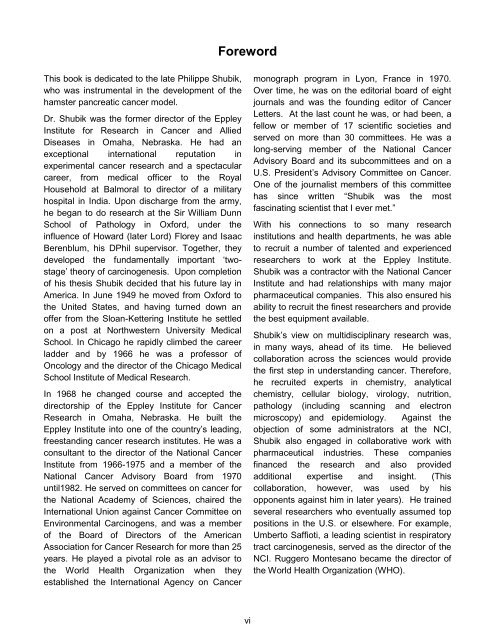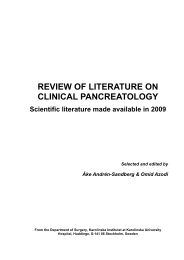Download PDF - The Pancreapedia
Download PDF - The Pancreapedia
Download PDF - The Pancreapedia
Create successful ePaper yourself
Turn your PDF publications into a flip-book with our unique Google optimized e-Paper software.
This book is dedicated to the late Philippe Shubik,<br />
who was instrumental in the development of the<br />
hamster pancreatic cancer model.<br />
Dr. Shubik was the former director of the Eppley<br />
Institute for Research in Cancer and Allied<br />
Diseases in Omaha, Nebraska. He had an<br />
exceptional international reputation in<br />
experimental cancer research and a spectacular<br />
career, from medical officer to the Royal<br />
Household at Balmoral to director of a military<br />
hospital in India. Upon discharge from the army,<br />
he began to do research at the Sir William Dunn<br />
School of Pathology in Oxford, under the<br />
influence of Howard (later Lord) Florey and Isaac<br />
Berenblum, his DPhil supervisor. Together, they<br />
developed the fundamentally important ‘twostage’<br />
theory of carcinogenesis. Upon completion<br />
of his thesis Shubik decided that his future lay in<br />
America. In June 1949 he moved from Oxford to<br />
the United States, and having turned down an<br />
offer from the Sloan-Kettering Institute he settled<br />
on a post at Northwestern University Medical<br />
School. In Chicago he rapidly climbed the career<br />
ladder and by 1966 he was a professor of<br />
Oncology and the director of the Chicago Medical<br />
School Institute of Medical Research.<br />
In 1968 he changed course and accepted the<br />
directorship of the Eppley Institute for Cancer<br />
Research in Omaha, Nebraska. He built the<br />
Eppley Institute into one of the country’s leading,<br />
freestanding cancer research institutes. He was a<br />
consultant to the director of the National Cancer<br />
Institute from 1966-1975 and a member of the<br />
National Cancer Advisory Board from 1970<br />
until1982. He served on committees on cancer for<br />
the National Academy of Sciences, chaired the<br />
International Union against Cancer Committee on<br />
Environmental Carcinogens, and was a member<br />
of the Board of Directors of the American<br />
Association for Cancer Research for more than 25<br />
years. He played a pivotal role as an advisor to<br />
the World Health Organization when they<br />
established the International Agency on Cancer<br />
Foreword<br />
vi<br />
monograph program in Lyon, France in 1970.<br />
Over time, he was on the editorial board of eight<br />
journals and was the founding editor of Cancer<br />
Letters. At the last count he was, or had been, a<br />
fellow or member of 17 scientific societies and<br />
served on more than 30 committees. He was a<br />
long-serving member of the National Cancer<br />
Advisory Board and its subcommittees and on a<br />
U.S. President’s Advisory Committee on Cancer.<br />
One of the journalist members of this committee<br />
has since written “Shubik was the most<br />
fascinating scientist that I ever met.”<br />
With his connections to so many research<br />
institutions and health departments, he was able<br />
to recruit a number of talented and experienced<br />
researchers to work at the Eppley Institute.<br />
Shubik was a contractor with the National Cancer<br />
Institute and had relationships with many major<br />
pharmaceutical companies. This also ensured his<br />
ability to recruit the finest researchers and provide<br />
the best equipment available.<br />
Shubik’s view on multidisciplinary research was,<br />
in many ways, ahead of its time. He believed<br />
collaboration across the sciences would provide<br />
the first step in understanding cancer. <strong>The</strong>refore,<br />
he recruited experts in chemistry, analytical<br />
chemistry, cellular biology, virology, nutrition,<br />
pathology (including scanning and electron<br />
microscopy) and epidemiology. Against the<br />
objection of some administrators at the NCI,<br />
Shubik also engaged in collaborative work with<br />
pharmaceutical industries. <strong>The</strong>se companies<br />
financed the research and also provided<br />
additional expertise and insight. (This<br />
collaboration, however, was used by his<br />
opponents against him in later years). He trained<br />
several researchers who eventually assumed top<br />
positions in the U.S. or elsewhere. For example,<br />
Umberto Saffioti, a leading scientist in respiratory<br />
tract carcinogenesis, served as the director of the<br />
NCI. Ruggero Montesano became the director of<br />
the World Health Organization (WHO).












